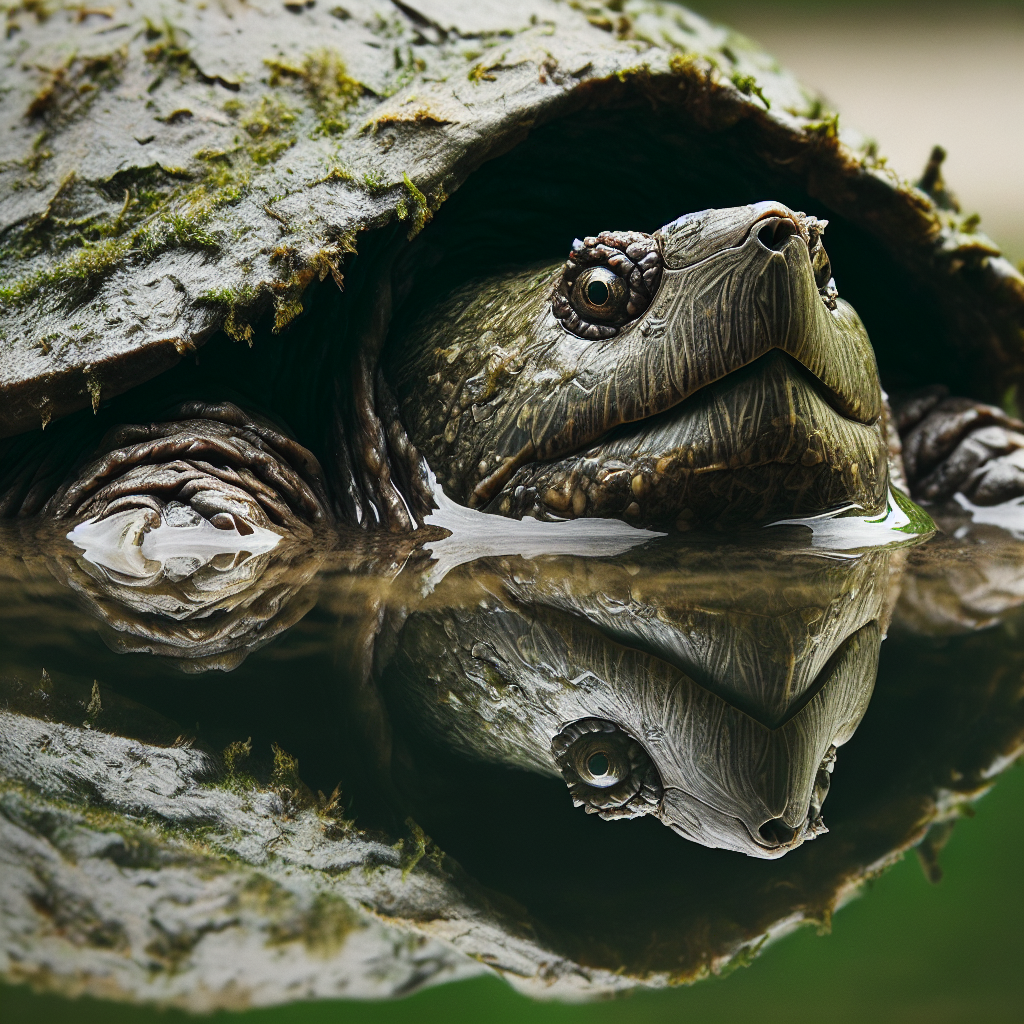Are you curious about how to identify a snapping turtle? Look no further! In this article, you will discover simple yet effective ways to determine if a turtle is indeed a snapping turtle. From their distinct physical features to their unique behavior, we will explore all the telltale signs that set these fascinating reptiles apart. So, whether you encounter a turtle in the wild or at a pet store, you’ll have the knowledge to confidently identify a snapping turtle when you see one. Get ready to become a turtle expert!
Physical Appearance
Shell
The shell of a snapping turtle is one of its most distinguishing features. It is characterized by its rough texture and jagged edges. The carapace, or upper shell, is dark brown or black in color and can have small, irregular shapes or patterns. The plastron, or lower shell, is lighter in color, typically a yellowish or grayish hue, and has a cross-like shape. The shell serves as protection for the snapping turtle, providing a safe retreat when threatened.
Head
The head of a snapping turtle is large and powerful, making it easy to identify. It has a pointed snout and a strong jaw with sharp, hooked beak-like jaws. The head is covered in rough skin and can range in color from dark brown to black. The eyes are positioned on the sides of the head, allowing the snapping turtle to have a wide field of vision. Its head is proportionally larger compared to other turtle species, making it a notable characteristic.
Jaws
The jaws of a snapping turtle are incredibly strong and capable of delivering a powerful bite. The upper jaw of a snapping turtle has a prominent hook-shaped beak, while the lower jaw is curved and serrated. These adaptations enable the snapping turtle to seize and hold onto prey effectively. The jaw strength and sharpness of the beak are essential for the snapping turtle’s carnivorous nature.
Tail
The tail of a snapping turtle is long and thick, extending beyond the shell. It is covered in bony plates and has a rough, scaled texture similar to the rest of the body. The tail is an important tool for the snapping turtle in the water, allowing it to swim gracefully and navigate through its aquatic habitat.
Size
Snapping turtles can vary in size depending on their age and species. Adult snapping turtles can reach significant lengths and weights. On average, they measure between 8 and 14 inches in length, with the carapace alone accounting for 5 to 9 inches. The larger alligator snapping turtle species can grow to be much larger, with some individuals surpassing two feet in length and weighing over 200 pounds. Young snapping turtles are generally smaller and more vulnerable until they reach maturity.
Behavior
Aggression
Snapping turtles are known for their aggressive behavior, especially when they feel threatened or cornered. They are quick to defend themselves and can snap their powerful jaws shut with incredible force. It is important to exercise caution and respect when encountering a snapping turtle, as provoking or handling them improperly can lead to injury. It is best to observe these fascinating creatures from a safe distance and allow them to go about their natural behaviors undisturbed.
Defensive Posture
When threatened, snapping turtles may assume a defensive posture to protect themselves. They typically retract their head and limbs into their shell, using their strong tail to hold their body firmly in place. This defensive posture helps shield vulnerable areas from potential predators or threats.
Basking Habits
Snapping turtles are ectothermic, meaning they rely on external sources of heat to regulate their body temperature. Basking is an essential behavior for snapping turtles, as it allows them to absorb heat from the sun’s rays. You can often find snapping turtles perched on logs or rocks near the water, stretching out their limbs and exposing themselves to the warmth of the sun. Basking also aids in digestion and overall metabolic function.
Swimming Style
Snapping turtles are highly adapted to their aquatic lifestyle and are proficient swimmers. They maneuver through the water using slow, deliberate strokes of their powerful legs and tail. While they may not be the fastest swimmers, they are agile and capable of traversing long distances. Their streamlined bodies, combined with their strong musculature, allow them to navigate their aquatic environment with ease.

Habitat
Aquatic Environment
Snapping turtles are highly adapted to live in aquatic environments such as lakes, ponds, rivers, and streams. They are often found in slow-moving or stagnant bodies of water with ample vegetation and a muddy or sandy substrate. These habitats provide the snapping turtle with abundant food sources, as well as concealment and protection. Snapping turtles spend a significant portion of their lives submerged in water, only venturing onto land for specific activities such as basking or nesting.
Terrestrial Habitat
Despite their preference for an aquatic environment, snapping turtles also require terrestrial habitat for certain activities. They will venture onto land to bask in the sun, lay their eggs, or even migrate to different bodies of water. Snapping turtles are known to travel considerable distances overland, utilizing their strong limbs and sharp claws to move across various terrains.
Geographical Distribution
Snapping turtles can be found in a wide range of geographical locations throughout North America. They are native to the United States and eastern Canada, with their range extending from the Atlantic Coast to the Mississippi River and its tributaries. Snapping turtles also inhabit parts of Central America and northern South America. They have been introduced to other areas outside their natural range, such as Europe and Asia, either intentionally or unintentionally.
Diet
Carnivorous Nature
Snapping turtles are primarily carnivorous, with a diet consisting of a wide variety of animal matter. From fish and frogs to birds and small mammals, snapping turtles are opportunistic feeders that will consume almost anything they can overpower. They also scavenge on carrion, making them important contributors to the natural ecosystem’s nutrient cycling.
Prey Preferences
While snapping turtles are known to be opportunistic predators, they do have certain prey preferences. They actively hunt and consume fish, including both small species and larger individuals. Frogs and tadpoles are also a favored food source, especially during the breeding season when aquatic habitats are abundant with amphibians. Snapping turtles have been observed feeding on reptiles, crustaceans, insects, and even plant matter to a lesser extent.
Feeding Techniques
Snapping turtles employ various feeding techniques to capture and consume their prey. Their powerful jaws allow them to seize and hold onto their victims securely. When hunting underwater, snapping turtles ambush their prey, relying on their excellent camouflage and patient stalking abilities to catch unwary animals. They may lunge forward from their hiding spots to snatch prey within the range of their jaws. Snapping turtles also rely on their strong sense of smell to detect prey, making them effective hunters in murky waters.

Nesting and Reproduction
Nesting Season
Snapping turtles engage in an annual nesting season, typically occurring in late spring or early summer for most species. This is a critical time for female snapping turtles to lay their eggs and begin the reproductive cycle. The exact timing of the nesting season can vary depending on geographical location and local environmental conditions.
Nest Site Selection
Female snapping turtles are selective in choosing their nest site. They prefer sandy or loose soil, often located in well-vegetated areas, such as sandy riverbanks or sandy areas near the edge of their aquatic habitat. These locations offer ideal conditions for egg incubation, providing suitable temperature and moisture levels.
Egg Characteristics
Snapping turtle eggs are small, round, and have a leathery texture. They are typically white or cream in color and measure approximately 1 to 1.5 inches in diameter. The eggs are deposited individually in the nest by the female and left to incubate.
Incubation Period
The incubation period for snapping turtle eggs can vary depending on temperature and other environmental factors. On average, it takes around 55 to 125 days for the eggs to hatch. The temperature at which the eggs are incubated plays a crucial role in determining the sex of the hatchlings, with higher temperatures favoring female offspring.
Hatchling Behavior
When the time comes for hatching, snapping turtle hatchlings use a special tooth called an “egg tooth” to break through the eggshell. Once hatched, they instinctively make their way towards the nearest water source. The journey from the nest to the water can be perilous for these tiny reptiles, as they are vulnerable to predators such as birds, raccoons, and even larger snapping turtles. Only a small percentage of hatchlings survive to adulthood, making it a critical period in their life cycle.
Identification Techniques
Carapace Shape
The shape of the snapping turtle’s carapace can provide valuable clues for identification. Unlike the smooth and streamlined shells of other turtle species, the carapace of a snapping turtle is rugged and irregular, often featuring a jagged edge. This unique shape is highly characteristic of snapping turtles and sets them apart from other species.
Shell Coloration
The coloration of the snapping turtle’s shell can vary depending on the individual and species. Typically, the carapace is a dark brown or black color, while the plastron is lighter, ranging from yellowish to gray. Some snapping turtles may have lighter or darker patches or patterns on their shells, adding to their distinctive appearance.
Head Features
The head of a snapping turtle is a significant identifier, as it is proportionally larger compared to other turtle species. The pointed snout, strong jaws with a hooked upper beak, and dark coloration of the head are key features to look out for. The position of the eyes on the sides of the head also contributes to the snapping turtle’s distinctive look.
Scale Patterns
The rough and scaly texture of a snapping turtle’s body is consistent throughout its shell, head, and limbs. Inspecting the scale patterns can aid in identification, as snapping turtles have unique scales that differ from those of other turtle species. The rough texture of the scales contributes to the snapping turtle’s overall appearance and serves as a protective barrier.
Size and Weight
Size and weight can also provide valuable information when identifying a snapping turtle. Adult snapping turtles can range in size from 8 to 14 inches in length, with some individuals surpassing two feet in length for larger species. Alligator snapping turtles, in particular, can grow to be much larger, weighing over 200 pounds in some cases. Juvenile snapping turtles are generally smaller and more vulnerable until they reach maturity.
Physical Comparisons
Comparing the physical characteristics of a turtle you encounter to reference materials or photographs can be immensely helpful in identifying whether it is a snapping turtle. Pay close attention to their shell shape, coloration, head features, scale patterns, and overall size. By considering these factors together, you can gain a clearer understanding of whether the turtle you are observing is indeed a snapping turtle.
Snapping Turtle vs Other Turtle Species
Differentiating Features
Differentiating between a snapping turtle and other turtle species can be challenging, especially for those unfamiliar with reptiles. Some key features that set snapping turtles apart from other turtles include their rough and rugged carapace, their large and powerful head, and their strong beak-like jaws. Other turtle species often have smoother shells, smaller heads, and less pronounced beaks.
Coloration Comparisons
When comparing the coloration of snapping turtles with other turtle species, the dark brown to black carapace of the snapping turtle is a distinguishing characteristic. Some species may have more vivid or unique color patterns on their shells, but the distinct dark color of the snapping turtle’s carapace is a useful identification feature.
Head Shape Identification
The shape of the head can also help in distinguishing between snapping turtles and other turtle species. The pointed snout, large size, and dark coloration of the snapping turtle’s head are notable identifiers. Comparing the head shape of a turtle to reference images or descriptions of snapping turtles can provide valuable insights into its species.
Jaw Structure Examination
Examining the jaw structure can offer valuable clues when identifying a turtle species. Snapping turtles have a unique jaw structure with a prominent hook-shaped upper beak and a curved, serrated lower jaw. These adaptations allow them to deliver powerful bites and differentiate them from other turtle species with different jaw structures.
Observation and Documentation
Field Observations
Conducting field observations is an excellent way to gather information about snapping turtles and their behavior. Spend time near bodies of water where snapping turtles are likely to be found. Observe their appearance, behavior, and interactions with their environment and other organisms. Take notes on their physical characteristics, such as shell shape, coloration, head features, and scale patterns.
Photographic Evidence
Photographic evidence can be a valuable tool for documenting and studying snapping turtles. Use a camera to capture clear images of snapping turtles from various angles. Ensure that the photographs capture important identifying features such as the shell, head, and scales. These photographs can aid in comparison with reference material or consultation with experts.
Video Documentation
Video documentation allows for a more comprehensive examination of snapping turtles’ behaviors and interactions with their surroundings. Record their movements, feeding habits, basking behaviors, and interactions with other organisms. Slow-motion footage can be particularly helpful for analyzing snapping turtles’ swimming style and jaw motions. Video documentation provides a valuable resource for future study and analysis.
Comparison with Reference Material
Once you have gathered observational data, photographs, and video documentation, compare your findings with reference materials. Field guides, scientific literature, and reputable online resources can aid in identifying and understanding snapping turtles’ distinctive characteristics. By comparing your observations and documentation with established information, you can refine your identification and interpretation.
Expert Consultation
Herpetologists
Herpetologists, scientists specializing in studying reptiles and amphibians, can provide valuable insights and expert knowledge about snapping turtles. They have extensive experience in identifying and studying various turtle species, including snapping turtles. Consult with a herpetologist to confirm your identification, discuss findings, and learn more about snapping turtles’ behavior, ecology, and conservation.
Wildlife Biologists
Wildlife biologists are professionals who study all aspects of wildlife, including their behavior, habitat requirements, and population dynamics. They can provide valuable information about snapping turtle populations in specific areas and offer guidance on conservation efforts. Wildlife biologists can also contribute to ongoing research and monitoring projects aimed at understanding and managing snapping turtle populations effectively.
Reptile Enthusiast Groups
Reptile enthusiast groups, such as local herpetological societies or online forums, are excellent resources for connecting with passionate individuals who share a keen interest in turtles. These groups often have members with valuable knowledge and firsthand experience with snapping turtles. Engage with these communities to learn from their experiences, exchange information, and contribute to citizen science initiatives.
Conservation Status and Legal Considerations
Protected Species
Snapping turtles are protected in many regions due to concerns over their declining populations. The International Union for Conservation of Nature (IUCN) lists several snapping turtle species as “vulnerable” or “endangered.” Various local, state, and federal laws protect snapping turtles from exploitation, habitat destruction, and illegal trade. It is important to be aware of and adhere to these protected status designations.
Local Regulations
Local regulations and laws can dictate specific guidelines and requirements when encountering snapping turtles. These regulations may include restrictions on interactions with snapping turtles, such as prohibiting handling or disturbance of nests. Familiarize yourself with the local regulations and ensure compliance to protect these fascinating reptiles and their habitats.
Permits and Licenses
In some cases, permits or licenses may be required to study or engage in activities involving snapping turtles. These permits ensure that individuals or organizations operating in the field are knowledgeable and follow ethical practices. Research the specific requirements in your area and obtain the necessary permits or licenses before conducting any studies or collecting data related to snapping turtles.
By understanding the physical appearance, behavior, habitat, diet, and identification techniques of snapping turtles, you can develop a comprehensive understanding of these remarkable reptiles. Remember to approach snapping turtles with caution and respect, and always prioritize their well-being and conservation.
